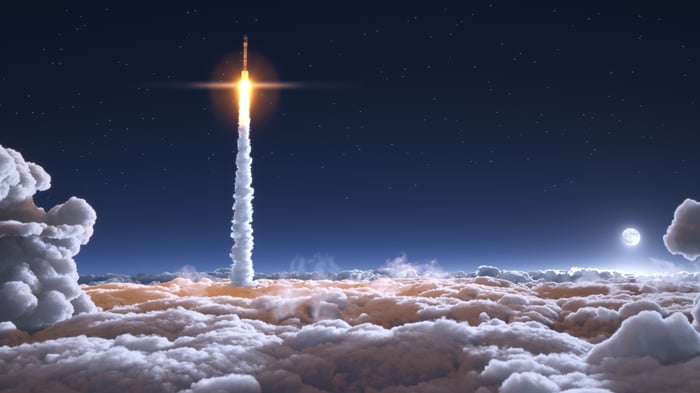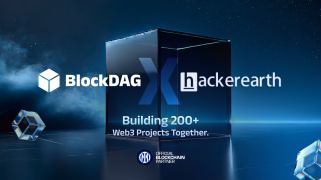KEY POINTS
- On Nov. 18, SpaceX blew up another Starship spaceship and its Super Heavy booster -- but that's just the start of the story.
- SpaceX got Starship to fly twice as long as last time in Saturday's test flight.
- At this point, regulatory delays may be the biggest obstacle to SpaceX doubling Starship's flight time all the way to 100% success.
Starship is getting better and better with each test flight -- and other space companies should be nervous.
Oops. It looks like SpaceX needs to build another Starship.
重點11 月18 日,SpaceX 炸毀了另一艘Starship 太空船及其超重型助推器——但這只是故事的開始。在周六的試飛中,SpaceX 讓Starship 的飛行時間是上次的兩倍。此時,監管方面的延誤可能是 SpaceX 將 Starship 飛行時間加倍直至 100% 成功的最大障礙。Starship 每次試飛都變得越來越好——其他航天公司應該感到緊張。哎呀。看起來 SpaceX 需要再建造一艘星際飛船。
On Saturday, SpaceX conducted its second-ever flight test of its Starship prototype interplanetary spaceship atop a Super Heavy booster rocket. And as multiple news outlets reported, it ended in disaster:
週六,SpaceX 在超重型助推火箭上對其 Starship 原型星際飛船進行了第二次飛行測試。正如多家新聞媒體報道的那樣,它以災難告終:
"Starship test launch ends in explosions" (CBS).
「星艦試射以爆炸告終」(哥倫比亞廣播公司)。
"Starship launch failed minutes after reaching space" (Reuters).
「星艦在到達太空幾分鐘後發射失敗」(路透社)。
"Starship achieves liftoff and separation, but 'mishap' results in loss of rocket" (NBC).
「星艦實現升空和分離,但『事故』導致火箭丟失」(NBC)。

IMAGE SOURCE: GETTY IMAGES.
圖片來源:蓋蒂圖片社。
Starship blew up. So did Super Heavy.
After launching from its pad near Boca Chica, Texas, at 8:02 a.m. ET on Saturday, Nov.18, SpaceX's booster exploded midflight about three and a half minutes after takeoff. Less than five minutes later, the Starship experienced its own "rapid unscheduled disassembly," apparently in response to an onboard self-destruct command.
星艦爆炸了。 Super Heavy 也是如此。美國東部時間11 月18 日星期六上午8 點02 分,SpaceX 的助推器在德克薩斯州博卡奇卡附近的發射台發射升空,起飛後約三分半鐘,在飛行途中爆炸。不到五分鐘後,星艦經歷了“快速的計劃外拆卸”,顯然是為了響應艦上的自毀命令。
But that doesn't mean the mission was a failure. Far from it.
但這並不意味著任務失敗。離得很遠。
The rest of the story
Yes, there were some big, Technicolor explosions, delivered in full Dolby surround sound. But SpaceX's Starship test flight last weekend also scored multiple successes:
故事的其餘部分是的,有一些大型的彩色爆炸,以完整的杜比環繞聲呈現。但 SpaceX 上週末的 Starship 試飛也取得了多項成功:
New launch pad technology muffled sound vibrations, and minimized damage to the pad. This greatly improved over April's test, when Super Heavy more or less destroyed its own pad in the process of launching from it.
新的發射台技術可消除聲音振動,並最大限度地減少對發射台的損壞。這比四月份的測試有了很大改進,當時超重型在發射過程中或多或少摧毀了自己的發射台。
All 33 Raptor engines on the Super Heavy Booster lit and stayed lit throughout the first stage's flight. This improved over April's test flight performance, when three engines flamed out.
超重型助推器上的所有 33 個猛禽發動機都點亮並在第一階段的飛行過程中保持點亮狀態。這比四月份的試飛性能有所改善,當時三台引擎熄火。
SpaceX proved the concept of "hot-stage separation," in which Starship's six engines lit while Super Heavy was still "on." Starship then powered away from Super Heavy while the latter turned off 30 of its 33 engines, and executed its patented flip-and-boostback maneuver to position itself for relanding back on Earth.
SpaceX 證明了「熱階段分離」的概念,其中星際飛船的六個引擎點燃,而超級重型仍然「開啟」。隨後,星艦脫離超重型發動機,而超重型發動機關閉了 33 個發動機中的 30 個,並執行了其專利的翻轉和助推機動,以重新著陸地球。
Starship itself then rocketed past the Karman line to space, getting to about 90 miles above the Earth before self-destructing.
隨後,星艦本身飛速沖過卡門線,飛向太空,到達距離地球約 90 英里的高度,然後自毀。
And with test flight 2 in the books, SpaceX is already getting ready for test flight No. 3. As CEO Elon Musk quickly confirmed, SpaceX will be ready to improve on last week's performance in less than one month, FAA permitting:
隨著第二次試飛的完成,SpaceX 已經為第三次試飛做好了準備。正如首席執行官埃隆·馬斯克(Elon Musk) 很快證實的那樣,在美國聯邦航空局(FAA) 允許的情況下,SpaceX 將在不到一個月的時間內準備好改善上週的表現:
Countdown to 100% success
Of course, that's the real rub. The fact that Starship and Super Heavy weren't 100% successful last week means the Federal Aviation Administration will want to do another "mishap" investigation before allowing SpaceX to try again. And it took the FAA seven months after test flight 1 to OK test flight 2. If it has to wait seven more months for test flight No. 3 -- and for each test flight thereafter -- then things could start to get tricky for SpaceX as it races to get Starship ready to perform a moon landing for NASA under the latter's Project Artemis.
100% 成功倒數 當然,這才是真正的難題。上週 Starship 和 Super Heavy 並未 100% 成功,這意味著美國聯邦航空管理局將希望在允許 SpaceX 再次嘗試之前進行另一次「事故」調查。從第一次試飛到第二次試飛,美國聯邦航空局花了七個月的時間。如果第三次試飛以及此後的每次試飛還需要再等七個月,那麼對於SpaceX 來說事情可能會開始變得棘手它正在競相讓星際飛船為美國宇航局的阿耳忒彌斯計劃下的登月做好準備。
Consider: Test flight 1 aimed to fly for 90 minutes before both halves of the Starship-Super Heavy combo returned to Earth -- but it actually flew fewer than four minutes. Test flight 2 doubled that flight time to eight minutes before rapid unscheduled disassembly.
想想看:試飛 1 的目標是在星艦-超重型組合體的兩半返回地球之前飛行 90 分鐘,但實際上只飛行了不到四分鐘。第二次試飛使飛行時間增加了一倍,達到八分鐘,然後才進行快速的計劃外拆卸。
Now, mathematically speaking, if SpaceX keeps doubling Starship's lifespan with each flight, but the FAA interposes seven-month-long waits between flights, then it might take SpaceX four more test flights to reach 100% success for Starship and Superheavy 28 months from now. This implies a 100% successful Starship system might not arrive before early 2026 -- too late for SpaceX to facilitate NASA's Artemis 3 mission to land astronauts on the moon planned for December 2025.
現在,從數學上講,如果SpaceX 在每次飛行中不斷將Starship 的壽命延長一倍,但FAA 在兩次飛行之間插入長達7 個月的等待時間,那麼SpaceX 可能需要再進行四次測試飛行,才能在28 個月後實現Starship 和Superheavy 100% 的成功。這意味著 100% 成功的 Starship 系統可能不會在 2026 年初之前到達,對於 SpaceX 來說太晚了,無法協助 NASA 計劃於 2025 年 12 月將太空人送上月球的 Artemis 3 任務。
The timeline gets even more cramped when you recall that, even after Starship is proven safe to fly cargo, SpaceX will want to test-fly Starship multiple times before putting astronauts on the spaceship, to ensure it's safe for humans.
當你回想起來,即使在Starship 被證明可以安全地運送貨物之後,SpaceX 仍希望在將宇航員送上飛船之前多次試飛Starship,以確保它對人類來說是安全的,時間線會變得更加狹窄。
Good news for SpaceX -- and bad news for everyone else
So there's risk to NASA's Project Artemis timeline here. There's also some risk to SpaceX, which may have to wait a bit longer to win additional contracts for additional moon landings, if Artemis is delayed while waiting for Starship to achieve human-rating certification. But the good news for SpaceX -- and the bad news for everyone else who builds rockets -- is that SpaceX is getting closer and closer to success.
對 SpaceX 來說是個好消息,但對其他人來說卻是壞消息因此,NASA 的阿爾忒彌斯計畫時間表存在風險。 SpaceX 也面臨一些風險,如果阿耳忒彌斯號在等待星際飛船獲得人類評級認證期間被推遲,該公司可能需要等待更長的時間才能贏得額外的登月合約。但對 SpaceX 來說,好消息——對其他製造火箭的人來說則是個壞消息——SpaceX 距離成功越來越近了。
Assuming Starship continues to make progress, we're getting closer to the day when SpaceX will possess: (1) the world's largest, most powerful rocket that (2) is fully reusable and (3) therefore doesn't need to be built from scratch for each launch, enabling SpaceX to (4) conduct space launches of both cargo and astronauts for as little as $2 million to $10 million per launch.
假設 Starship 繼續取得進展,我們距離 SpaceX 將擁有的那一天越來越近了:(1) 世界上最大、最強大的火箭 (2) 完全可重複使用,(3) 因此不需要用它來建造每次發射都免費,使SpaceX 能夠(4) 以每次發射200 萬至1000 萬美元的成本進行貨物和宇航員的太空發射。
Countdown to 100% success
Of course, that's the real rub. The fact that Starship and Super Heavy weren't 100% successful last week means the Federal Aviation Administration will want to do another "mishap" investigation before allowing SpaceX to try again. And it took the FAA seven months after test flight 1 to OK test flight 2. If it has to wait seven more months for test flight No. 3 -- and for each test flight thereafter -- then things could start to get tricky for SpaceX as it races to get Starship ready to perform a moon landing for NASA under the latter's Project Artemis.
100% 成功倒數 當然,這才是真正的難題。上週 Starship 和 Super Heavy 並未 100% 成功,這意味著美國聯邦航空管理局將希望在允許 SpaceX 再次嘗試之前進行另一次「事故」調查。從第一次試飛到第二次試飛,美國聯邦航空局花了七個月的時間。如果第三次試飛以及此後的每次試飛還需要再等七個月,那麼對於SpaceX 來說事情可能會開始變得棘手它正在競相讓星際飛船為美國宇航局的阿耳忒彌斯計劃下的登月做好準備。
Consider: Test flight 1 aimed to fly for 90 minutes before both halves of the Starship-Super Heavy combo returned to Earth -- but it actually flew fewer than four minutes. Test flight 2 doubled that flight time to eight minutes before rapid unscheduled disassembly.
想想看:試飛 1 的目標是在星艦-超重型組合體的兩半返回地球之前飛行 90 分鐘,但實際上只飛行了不到四分鐘。第二次試飛使飛行時間增加了一倍,達到八分鐘,然後才進行快速的計劃外拆卸。
Now, mathematically speaking, if SpaceX keeps doubling Starship's lifespan with each flight, but the FAA interposes seven-month-long waits between flights, then it might take SpaceX four more test flights to reach 100% success for Starship and Superheavy 28 months from now. This implies a 100% successful Starship system might not arrive before early 2026 -- too late for SpaceX to facilitate NASA's Artemis 3 mission to land astronauts on the moon planned for December 2025.
現在,從數學上講,如果SpaceX 在每次飛行中不斷將Starship 的壽命延長一倍,但FAA 在兩次飛行之間插入長達7 個月的等待時間,那麼SpaceX 可能需要再進行四次測試飛行,才能在28 個月後實現Starship 和Superheavy 100% 的成功。這意味著 100% 成功的 Starship 系統可能不會在 2026 年初之前到達,對於 SpaceX 來說太晚了,無法協助 NASA 計劃於 2025 年 12 月將太空人送上月球的 Artemis 3 任務。
The timeline gets even more cramped when you recall that, even after Starship is proven safe to fly cargo, SpaceX will want to test-fly Starship multiple times before putting astronauts on the spaceship, to ensure it's safe for humans.
當你回想起來,即使在Starship 被證明可以安全地運送貨物之後,SpaceX 仍希望在將宇航員送上飛船之前多次試飛Starship,以確保它對人類來說是安全的,時間線會變得更加狹窄。
Good news for SpaceX -- and bad news for everyone else
So there's risk to NASA's Project Artemis timeline here. There's also some risk to SpaceX, which may have to wait a bit longer to win additional contracts for additional moon landings, if Artemis is delayed while waiting for Starship to achieve human-rating certification. But the good news for SpaceX -- and the bad news for everyone else who builds rockets -- is that SpaceX is getting closer and closer to success.
對 SpaceX 來說是個好消息,但對其他人來說卻是壞消息因此,NASA 的阿爾忒彌斯計畫時間表存在風險。 SpaceX 也面臨一些風險,如果阿耳忒彌斯號在等待星際飛船獲得人類評級認證期間被推遲,該公司可能需要等待更長的時間才能贏得額外的登月合約。但對 SpaceX 來說,好消息——對其他製造火箭的人來說則是個壞消息——SpaceX 距離成功越來越近了。
Assuming Starship continues to make progress, we're getting closer to the day when SpaceX will possess: (1) the world's largest, most powerful rocket that (2) is fully reusable and (3) therefore doesn't need to be built from scratch for each launch, enabling SpaceX to (4) conduct space launches of both cargo and astronauts for as little as $2 million to $10 million per launch.
假設 Starship 繼續取得進展,我們距離 SpaceX 將擁有的那一天越來越近了:(1) 世界上最大、最強大的火箭 (2) 完全可重複使用,(3) 因此不需要用它來建造每次發射都免費,使SpaceX 能夠(4) 以每次發射200 萬至1000 萬美元的成本進行貨物和宇航員的太空發射。
When everyone else on Earth is still trying to launch rockets for prices measured in the tens and hundreds of millions -- and billions -- of dollars per launch, that's going to make SpaceX the undisputed cheapest rocket launcher on Earth, and potentially make every other rocket and every other rocket company on the planet obsolete.
當地球上的其他人仍在嘗試以每次發射數千萬、數億甚至數十億美元的價格發射火箭時,這將使SpaceX 成為地球上無可爭議的最便宜的火箭發射器,並且有可能使其他所有火箭發射器都變得更便宜。火箭和地球上所有其他火箭公司都已經過時了。


 Optimisus
Optimisus Optimisus
Optimisus Optimisus
Optimisus Thecryptoupdates
Thecryptoupdates DogeHome
DogeHome The Crypto Times
The Crypto Times Coincu
Coincu Optimisus
Optimisus Coin_Gabbar
Coin_Gabbar






















